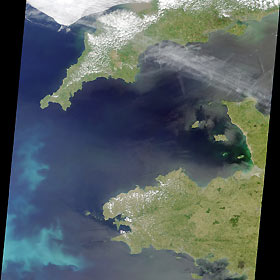
Save this image free of charge
in 800 pixels for layout use
(right click, Save as...)
|
|
Ref : V01146
Theme :
Countries-Continents (seen from Space) (255 images)
Title : Coccoliths in the Celtic Sea
Caption :
As the basis of the marine foodchain, phytoplankton are important indicators of change in the oceans. These marine flora also extract carbon dioxide from the atmosphere for use in photosynthesis, and play an important role in global climate. Phytoplankton blooms that occur near the surface are readily visible from space, enabling a global estimation of the presence of chlorophyll and other pigments. There are more than 5,000 different species of phytoplankton however, and it is not always possible to identify the type of phytoplankton present using space-based remote sensing. Coccolithophores, however, are a group of phytoplankton that are identifiable from space. These microscopic plants armor themselves with external plates of calcium carbonate. The plates, or coccoliths, give the ocean a milky white or turquoise appearance during intense blooms. The long-term flux of coccoliths to the ocean floor is the main process responsible for the formation of chalk and limestone. This image is a natural-color view of the Celtic Sea and English Channel regions, and was acquired by the Multi-angle Imaging SpectroRadiometer nadir (vertical-viewing) camera on June 4, 2001. It represents an area of 380 kilometers by 445 kilometers, and includes portions of southwestern England and northwestern France. The coccolithophore bloom in the lower lefthand corner usually occurs in the Celtic Sea for several weeks in summer. The coccoliths backscatter light from the water column to create a bright optical effect. Other algal and/or phytoplankton blooms can also be discerned along the coasts near Portsmouth, England, and Granville, France.
|
|

